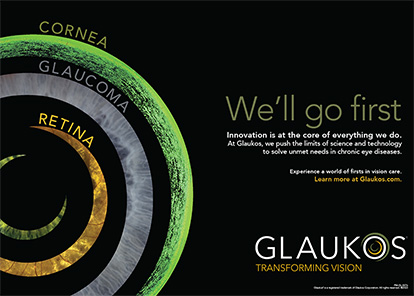
Surgeons and patients benefit when a surgical procedure is simplified. Ocular sealants and glues offer a convenient, safe, and highly effective alternative to sutures. The ReSure Sealant (Ocular Therapeutix) is labeled for use on clear corneal incisions after cataract surgery.1 Compared with sutures, I have found that this sealant can make corneal transplant surgery or Descemet stripping endothelial keratoplasty (DSEK) simpler and faster. Plus, I feel confident that my patients’ wounds will remain closed and properly pressurized, thus ensuring a successful graft.
In select cataract cases, I use an ocular sealant when a typical 3-mm incision becomes stretched or misshapen due to a preexisting condition or as a result of manipulation. Based on this experience with the sealant, I opted to try it on my DSEK patients who require a 4-mm or larger main incision and two paracentesis incisions. Traditionally, a larger incision means that one or more stitches will be needed to achieve an airtight, watertight closure, yet I never observed a 100% closure rate until I started using the ReSure Sealant.
TRADITIONAL DSEK
In the past, I told my DSEK patients that a suture was the best way to prevent fluid or air leakage and protect the graft. I also explained that, in some cases, a suture was required for one of the two smaller paracentesis incisions. Many patients expressed reluctance about having a stitch placed in their eye unless it was absolutely necessary. Although I sutured approximately 90% of my cases, I would occasionally opt not to suture wounds that seemed likely to seal on their own. Some of these unstitched wounds healed well; often, however, the air bubble dissipated overnight, resulting in a graft that would detach because the patient rubbed the eye, turned the eye the wrong way, or blinked and squeezed the eye too hard. Although graft detachment is not a serious problem, correction is time-consuming, because it requires the insertion of a new air bubble and a suture.
ADVANTAGES OF A SEALANT
At a Glance
• Ocular sealants offer a suture-free approach to corneal transplant surgery.
• Although more expensive than sutures, ocular sealants are easy to use and safe for patients, and they save surgeons time.
Stable IOP
I have not observed any complications to date from using an ocular sealant in my DSEK patients. Complications caused by air leakage could lead to low IOP and graft detachment.
Ease of Use
I have found that the DSEK procedure lends itself quite nicely to the use of the sealant. In cataract surgery, the wound must be dry before I administer the sealant. That means I must release fluid so that there is no more egress of fluid from the main incision, making the eye slightly hypotonous. In DSEK, there is always a water-free wound because of the air bubble. Fluid leakage into or out of the wound is not a concern. After I apply the sealant, I can confirm the durability of the seal by testing the wound by applying slight pressure adjacent to it and monitoring tactile IOP.
Cost-Effectiveness
Although the cost of the sealant is greater, the application process—from mixing to applying to polymerization—takes less than 30 seconds, which is significantly less time-consuming than suturing. In my experience, the time saved on the initial surgery easily makes up for any additional expense from using the sealant. Plus, there is no need for postoperative procedures due to graft failure or complications associated with suturing.
Patients’ Satisfaction
My patients are relieved when they learn that they will not have a stitch placed in their eye. The sealant remains on the eye for the first few postoperative days and gradually sloughs off in tears during re-epithelialization.
CASE STUDY
A patient was very anxious about combined cataract and DSEK surgery. She was adamant that she did not want a suture placed in her eye. I first performed phacoemulsification and removed the cataract under topical anesthesia. I then enlarged the incision from 3 to 4 mm to perform DSEK. The patient had a large cornea, meaning the graft was not going to cover the internal lip of the incision and would not be able to self-seal. I placed the air bubble and attempted to raise the IOP above 50 mm Hg, which is the pressure needed to maintain the graft’s placement. I was only able to reach an IOP of 25 mm Hg. I then painted the ReSure Sealant on the wound and let it dry, which took about 30 seconds. I placed a new air bubble through the paracentesis and almost instantly achieved an IOP above 50 mm Hg. I left the pressure at that level for 8 minutes and then removed half the air bubble to avoid pupillary block or angle closure. One hour later, the bubble remained stable at 50%, the graft was attached, and the IOP was normal at 20 to 25 mm Hg.
CONCLUSION
Incorporating an ocular sealant into my surgical practice has been advantageous. The sealant is innocuous to the patient, and its application is straightforward. In my experience, the product makes the procedure safer, hastens healing times, and contributes to better outcomes. I also avoid the cost and time it takes to place a suture and later remove it. I feel confident that I will get a nice, sealed, airtight anterior chamber every time.
1. ReSure Sealant [package insert]. Bedford, MA: Ocular Therapeutix; 2014.
Keith A. Walter, MD
• professor of ophthalmology, Wake Forest Baptist Medical Center, Winston-Salem, North Carolina
• (336) 716-4091; kwalter@wakehealth.edu
• financial interest: none acknowledged


